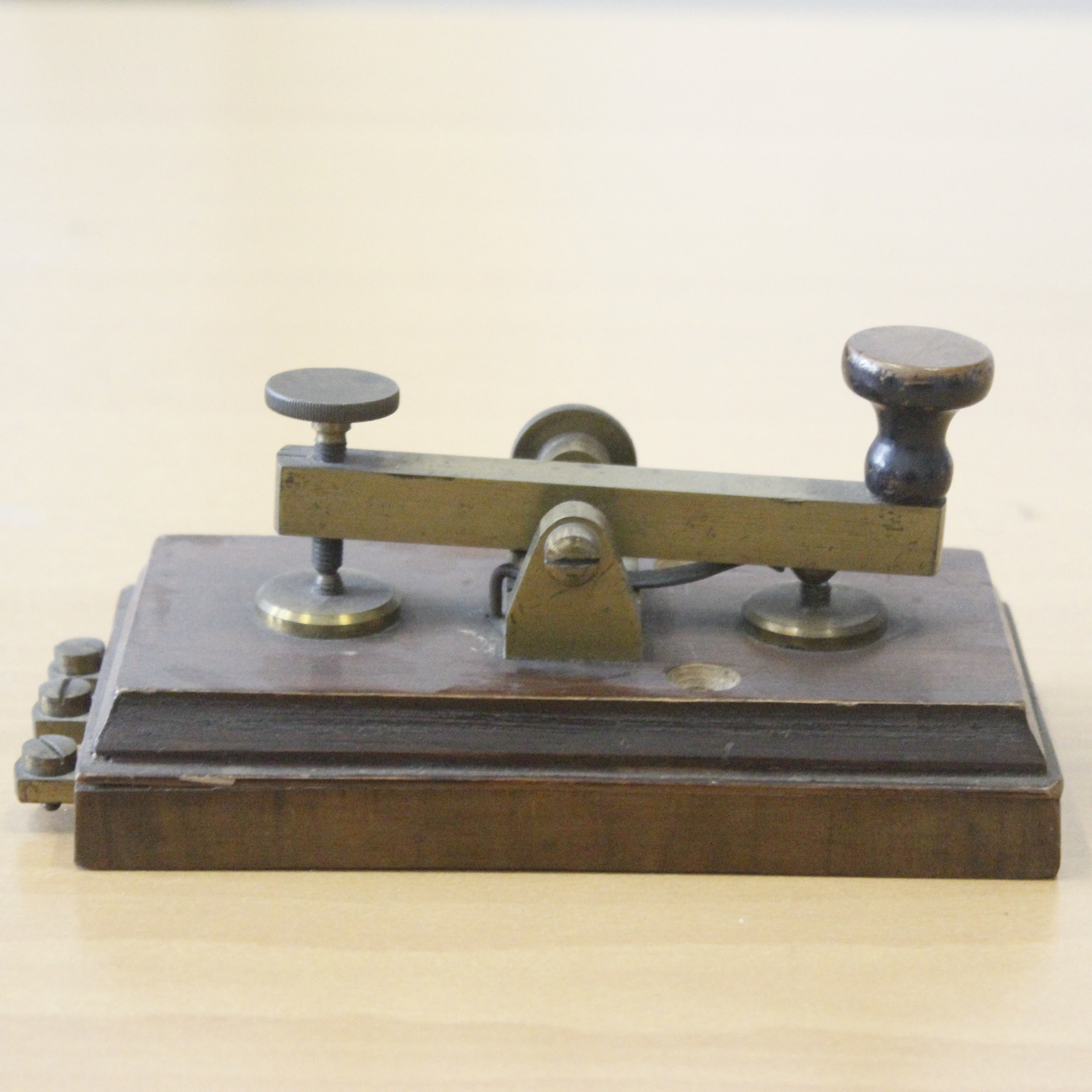
A telegraph key is mainly an electric switch, used by a trained operator to transmit text messages in telegraph systems, generally using the Morse code. The telegraph keys were used in all electrical telegraphy systems, either "wired" or "wireless”. By tapping on a switch, the operator closes and opens an electrical circuit, thus creating electrical pulses of two different lengths called "dots" and "dashes"., thus allowing the operator to send encoded messages.
Insights
The telegraph key is the device used by the telegraph operator to send pulses from the transmission station.
According to the Morse code, briefly pressing the switch produces a “dot” pulse.
Instead, by pressing the switch for a longer time a “dash” pulse is produced. If the operator does not press the button, a contact located at the back of the switch creates a connection with the receiving station, which could in turn send a message.
Although universally attributed to Samuel Morse, the authorship of telegraphy is shared with Alfred Vail, who is probably the true inventor of the Morse Code, and who was the inventor of the first true telegraph key.
It was Alfred Vail who received Morse's message to Baltimore and successfully returned the same message to Morse in Washington. For Vail, this event was the culmination of years of work and financial investments.
Vail greatly improved the original design and mechanics of the Morse machine. He also replaced the pencil that Morse had used in its machine to write the code on paper tape with a pointed steel pen.
He also perfected the mechanics of the register, the instrument that pierced the tape with an electrical impulse.
Vail also developed a simpler alphabetical code system to replace the original Morse code, which was more complex to use. In fact, dots and dashes in Vail’s code were interpreted as numbers, and then translated into words using a code book. Vail's alpha code has greatly accelerated the message decoding process.
Although Vail's contributions to the project were extremely significant, it was the name of Morse that appeared on the patents. As a result, Morse is remembered, but often there is no mention of Vail.
In addition, Vail received just $ 900 a year to work on the telegraph, so he retired and wrote a letter to Morse saying that he had decided to leave the Telegraph (Washington and New Orleans Telegraph Company) to take care of himself In the same letter Vail informed Morse
that he had decided to leave the Telegraph (Washington and New Orleans Telegraph Company) to take care of himself.
of his intention to leave Washington for New Jersey and to abandon the Telegraph business for other more profitable deals. In the same letter Vail informed Morse of his intention to leave Washington for New Jersey and to abandon the Telegraph business for other more profitable deals.
It took Morse several months to compile his dictionary for the code. Morse supporters claim that Vail, in both public and private writings, has never claimed the code for himself. According to a researcher, in a letter of February 1838 to his father, judge Stephen Vail, Alfred Vail wrote: "Professor Morse has invented a new alphabet and has thrown aside dictionaries". In an 1845 book, Vail described the Morse telegraph, attributing the code to Morse.
Reading Vail's notes and letters in the Smithsonian, one can deduce that what pushed him to research was not the desire for fame, but simply the satisfaction of having a project to work on, and maybe that was enough for him.
Despite this, the Vail family filed a lawsuit against the widow of Morse to claim the invention of the telegraph.
Today the telegraphic key is still used by radio amateurs. In the modern form, the manipulator, as it is called in jargon, consists of a lever that can be pushed sideways in both directions. If the lever is pushed in one direction, a special circuit generates a point. If moved in the other direction, it generates
a line. In this way, the typing speed increases considerably, and the duration of points and lines is determined with greater precision.
Technical Data Sheet
Category: Telegraph
Inventor: Samuel Morse, Alfred Vail
Year of production: 1844
Size: 7x15x7,5
Sources
http://www.aribg.it/levoluzione-dei-tasti-telegrafici-moderni/
https://siarchives.si.edu/blog/forgotten-history-alfred-vail-and-samuel-morse
https://en.wikipedia.org/wiki/Alfred_Vail
http://www.radioamatori-rai.it/appoggio/Lo%20sviluppo%20del%20tasto%20telegrafico%20nel%20sistema%20di%20Morse.pdf https://en.wikipedia.org/wiki/Alfred_Vail






